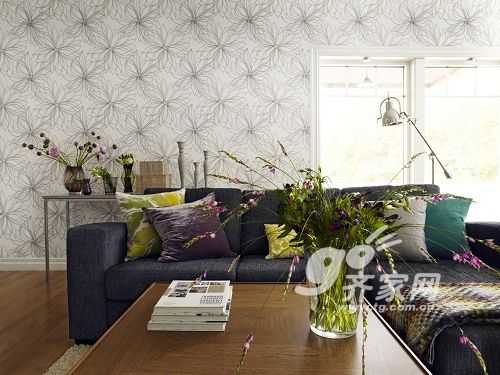Compared with the wall paint, the wallpaper has the advantages of rich patterns, convenient replacement, better air permeability, and more environmental protection. Therefore, many owners are more inclined to choose the former when they like high-end feelings and do not care too much about prices. The laying process of wallpaper directly affects the visual effect and future maintenance after completion. This article will explain the whole process and the matters needing attention in a simple way. Preparatory preparation I. Wall treatment If there is a seam on the wall, you need to use a putty to make up the seam first, and then use a putty to add more white plastic (vinyl acetate resin). If there is loose powder or dust on the wall, it should be removed by sanding. A wall that is too smooth is not easy to absorb glue, then the force will drop, and it must be sanded before wallpapering. After the above process is completed, a layer of base film is required to form a protective film between the wall surface and the wallpaper, which can not only protect the wall surface but also prevent the water, salt, and alkali from penetrating the erosion of the wallpaper, and effectively protect the decoration material from mold erosion. . Two. Glue preparation The glue is generally made of a mixture of wallpaper glue and white glue. The viscosity is appropriate and easy to brush. The viscosity is adjusted by the amount of water added. The wallpaper powder is natural starch and the white glue is synthetic resin (vinyl acetate resin). In order to ensure good wallpaper paste effect, different amounts of white glue are often added according to different wallpapers. The cloth surface of the cloth is thicker, and the glue preparation is thicker than other wallpapers. The white glue and wall powder below 15 ounces can be used to modulate. The product with 15 ounces or more can be used for special glue on the wall cloth. The special glue can be applied for 5 squares per kilogram. Meter. three. Wallpaper clipping Take a roll of wallpaper and check the pattern, pattern, and direction. After determining which direction is facing upwards, use the top of the kickboard floor as a starting point, measure the height of the wall with a tape measure, and then spread the wallpaper on the table to spread the glue. With the pattern facing downwards, after measuring the length, use a pencil to draw a marking on the back, and then use the scissors to cut the pencil line. According to the wall section size, according to the wallpaper pattern spelling required to cut a good paper, numbered on the corresponding number, two set aside 30 --- 50MM amount of cutting, flat put aside. Mid-term construction Put the roller used for glue to soak for 30 seconds in the equipped glue. Roller should be rolled in the same direction when the roller is brushed. Roller and wallpaper are lightly brushed at 45 degrees. Can't brush back and forth, so it's easy to wrinkle the wallpaper. When brushing, the movement should be smooth and uniform, holding the drum in one hand and the other hand fixed in the place where there is no brush; so as not to roll up the wallpaper. After all, use a small brush to apply a special glue (wallpaper powder and white glue ratio 1:1) to the edge of the wallpaper. After gluing the wallpaper, it will be affixed to the wall and it must be smoothed out to drive out the air bubbles. General plastic wallpaper is more washable, so you can use the "plastic scraper" to gently level the surface, drive out the bubbles, if a small amount of glue out of the surface, should immediately wipe clean with a wet sponge, scraper can not be too hard, or easy to scrape Injured surfaces cause print fading, reflection, and obvious seams. The surface of high-grade textile wall cloth is vulnerable to damage, as long as the brush is brushed gently with a short-bristle brush, and the glue must be applied in appropriate amounts. The glue must not be driven out of the joints to contaminate the surface, otherwise it cannot be processed. The paper wallpaper is very delicate and can only be used with short-bristled brushes. The glue should not be allowed to touch the surface. If it touches the surface, it should be wiped clean immediately. Otherwise, the glue will not be removed after drying, and it will cause the disadvantage of color difference. When any wallpaper is used, the glue should not stick to the surface of the wallpaper, which is the most perfect construction process. After all wallpapers are posted, they should be carefully checked again and check the contents: 1) Whether the seams are aligned or not. 2) Whether there is a bubble. 3) Whether the pattern does not match. 4) crease The following methods should be remedied if: A, joints loosen: Use a knife to pick up the seams, inject glue from the slits, use the scraper to level off, wipe off excess glue. B. Bubbles: Cut with a utility knife, inject glue at the opening, and apply it to the flat surface to wipe off excess glue. C, pattern does not match: due to inaccurate buildings, such as uneven foundation settlement, caused by flowers can not let it appear in the inconspicuous corner. D, from the crease: Use a utility knife to cut the creases, add glue, roll flat with a roller, if not flat, use "replenishment ingots" way. E, wet plaque: usually no wallpaper defects; may be a problem with the wall, to consult the relevant experts. F, black spots: Most black spots indicate problems with the walls such as: mildew, water seepage, etc.; remove some of the moisture from the wallpaper and coat with mildew-proof glue. Flooring Purchase Nature Flooring Flooring Flooring Flooring Wallpaper Window Lacquer Flooring Curtain Fabric Curtains 
Aishe Wallpaper   City Curtain City